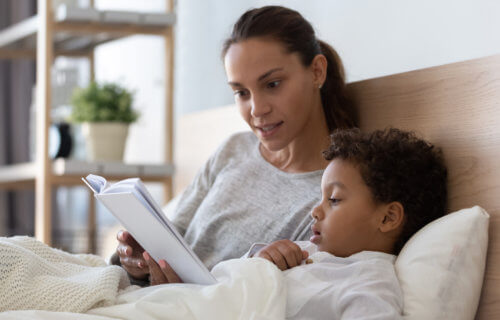RIO DE JANEIRO, Brazil — Can “story time” be just as beneficial to children under the weather as chicken soup? As it turns out, yes, a new study finds bedtime stories really do make children in the hospital feel better.
Researchers in Brazil say reading to hospitalized kids reduces pain and stress by fueling certain hormones in the brain. Specifically, reading to children in intensive care boosts their quality of life, the study reports.
Tall tales are as old as time itself. They can range from myths and legends to fables, ghost yarns, and heroic adventures. While it may be common knowledge a good story can help little ones feel secure and sleepy, the new findings show they also relieve symptoms of illness and pain. Researchers adds they are also twice as effective as other forms of entertainment, such as riddles.
“During storytelling, something happens that we call the ‘transport of narrative’, that is, the child, through fantasy, can experience sensations and thoughts that transport them, momentarily, to another world, another place, different from the hospital room and, therefore, away from the aversive conditions of hospitalization,” says study first author Dr. Guilherme Brockington, from the Instituto D’Or de Pesquisa e Ensino (IDOR) and Federal University of ABC, in a media release.
Boosting the ‘love hormone’
The study finds storytelling increases levels of oxytocin, called the “love hormone.” It also helps to reduce cortisol, a hormone released during stress. Cave art shows storytelling dates back to our prehistoric ancestors. It spans at least tens of thousands of years through speech, writing, and imagery. Today, films and books captivate audiences through the same mechanism, moving people from one reality to another.
Driven by imagination, researchers say storytelling can create empathy for events and characters. It also fluctuates according to the interpretation of each individual.
“Until then, the positive evidence of the act of telling stories was based on ‘common sense’, in which interaction with the child could distract, entertain, relieve some suffering. But there was a lack of a solid scientific basis, especially with regard to underlying physiological mechanisms,” explains co-author Dr. Jorge Moll Neto.
Storytelling is twice as effective as playing games
The team identified the psychological and biological processes that occur during and after listening to a story. They selected 81 children between two and seven years-old in a Sao Paulo hospital with asthma, bronchitis, or pneumonia. Researchers randomly selected half the group, who had storytellers read to them for about 30 minutes. The other children were given riddles offered by the same professionals for the same period of time.
Study authors collected saliva samples to measure both hormones. The young participants also underwent pain examinations before and after the sessions. The team then confirmed the results using a word association task in which the children were shown seven cards. These depicted a nurse, doctor, hospital, medicine, patient, pain, and book.
Researchers report that the outcomes were actually positive for both groups, since both interventions reduced cortisol levels and increased oxytocin production. They add sensations of pain and discomfort also dropped, according to the children’s own reviews. The Brazilian team adds that the only major difference is that the impact of storytelling was twice as strong as telling children riddles.
The findings, appearing in the journal Proceedings of the National Academy of Sciences, show stories simply work much better.
“Another highlight of this study is that it was not performed in an artificial environment, but within the daily life of the pediatric ICU. The storytelling was done individually, the child chose what would be the story to be told. Among the books offered, we chose titles available in ordinary bookstores and without predefined emotional bias, so the story does not influence the child’s reaction so much after the activity,” says Dr. Brockington.
Bedtime stories in the hospital also help kids view doctors more positively
Storytelling has been adopted in many children’s hospitals, but this is the first evidence of its impact. It’s effective and cheap and makes a real difference, the study authors contend.
“I consider this study one of the most important of which I participated, due to its simplicity, rigor, and potential direct impact on hospital practices, aiming at the relief of suffering. As a low-cost, high-security intervention, it can potentially be implemented throughout the public system, as soon as larger-scale studies verify its reproducibility and efficacy. We intend to extend and replicate it in other places and groups and support the volunteering dedicated to this noble storytelling activity, now with more solid scientific evidence,” Dr. Moll Neto points out.
What’s more, children in the storytelling group reported more positive emotions when seeing the hospital, nurse, and doctor cards afterwards. For example, the children in the control group responded to the card with the drawing of a hospital saying, “this is where people go when they are sick.” Children in the storytelling group said, “this is the place that people go to get better.”
For the illustrations of a nurse and a doctor, the same pattern emerged. Children in the control group remarked, “it’s the bad girl who comes to stick me with the injection” while those who took part in the storytelling session said, “it’s the girl who comes to heal me.”
In addition to reducing anxiety and stress, the study finds storytelling enables the strengthening of bonds between children, the narrator, and other people present. The findings also have implications for children experiencing environmental stress, such as disruptions caused by the coronavirus pandemic.
SWNS writer Mark Waghorn contributed to this report.
